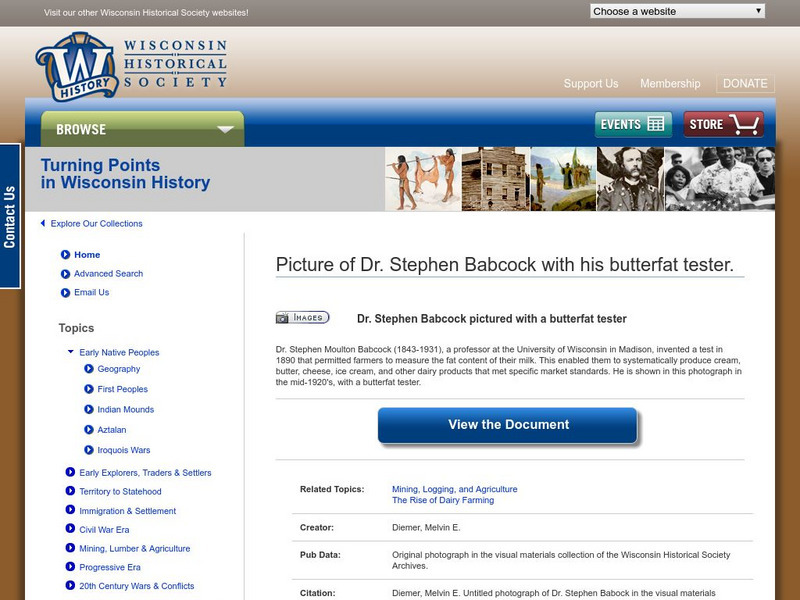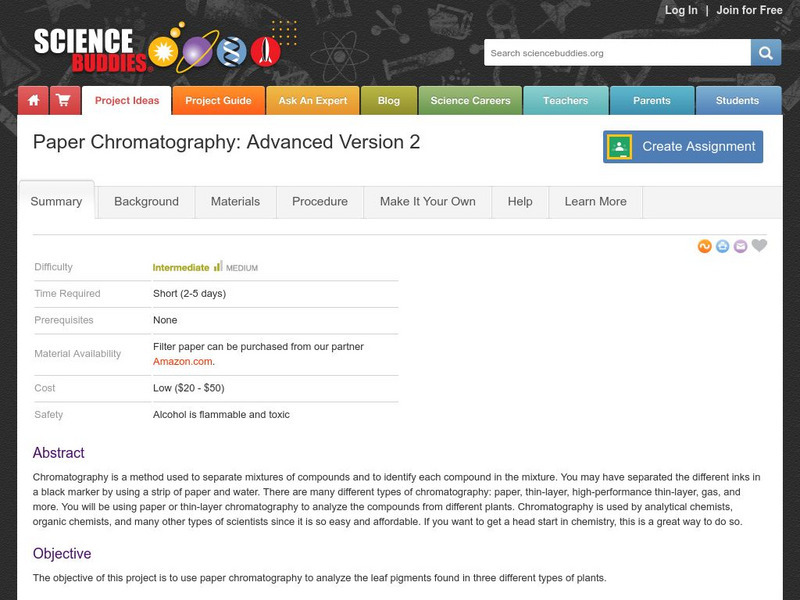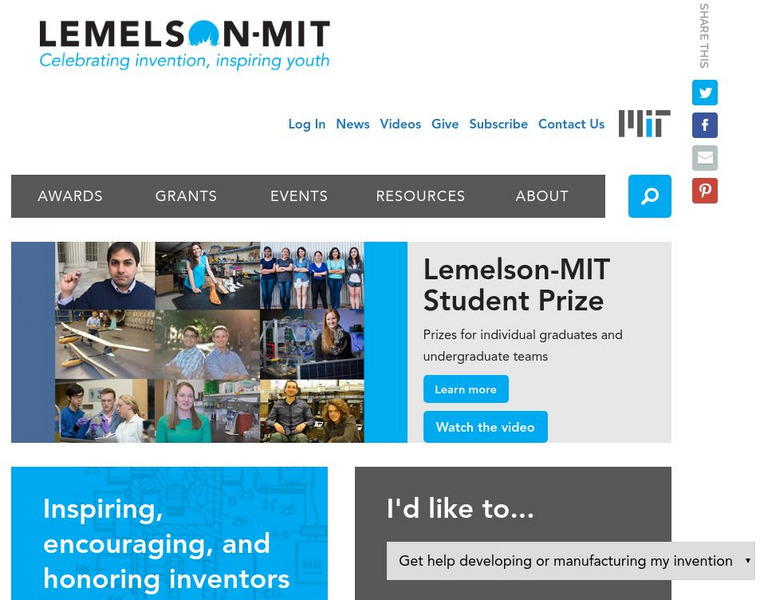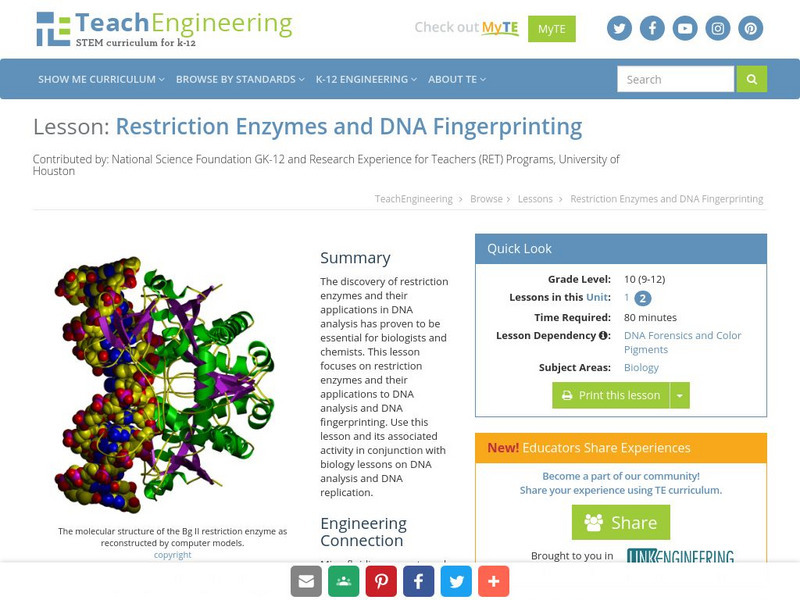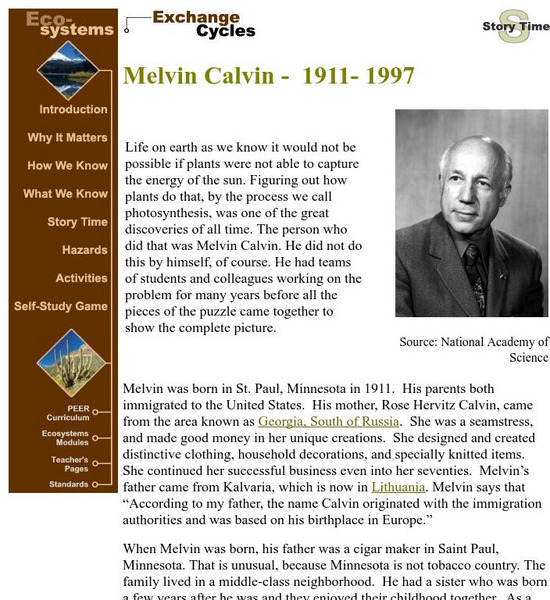Wisconsin Historical Society
Wisconsin Historical Society: Stephen Babcock
Stephen Babcock was an agricultural chemist in the 1800s whose work led to the later discovery of vitamins A and D. He developed the Babcock test which paved the way for standardizing the quality of milk sold and setting fair prices....
Robin Chew
Lucid Cafe: Louis Pasteur
Contains a short article on the life of French chemist Louis Pasteur. Contains helpful links to more information on Pasteur.
Chem4kids
Chem4 Kids: Chemistry in the Environment
This brief overview of the chemistry of the Earth gives students an idea of what environmental chemists might study.
Encyclopedia Britannica
Encyclopedia Britannica: Linus Pauling
This is a brief biography of Linus Pauling, the famous American chemist and two time Nobel Prize winner.
Other
Wired Chemist: Geometric & Optical Isomers
Discussion of two types of stereoisomers: geometrical and optical isomers.
Other
History of Chemistry: Fritz Haber: Chemist and Patriot
Contains biographical information about Fritz Haber, Nobel Prize winner from Germany.
Science Buddies
Science Buddies: Paper Chromatography: Advanced Version 2
Chromatography is a method used to separate mixtures of compounds and to identify each compound in the mixture. You may have separated the different inks in a black marker by using a strip of paper and water. There are many different...
Science Buddies
Science Buddies: Make Your Own Markers
Do you ever wonder how markers are made? Where do all of those colors come from? Many of the colorful dyes we use come from plant pigments. Pigments are what make the world around us so colorful. How do chemists turn those natural plant...
Science Buddies
Science Buddies: Potions and Lotions: Lessons in Cosmetic Chemistry
Did you know that cosmetic companies employ teams of specialized chemists to develop and test each new line of make up, perfume, lotion, or soap? Here's a project that lets you be the cosmetic chemist. It shows you how to manufacture...
BBC
Bbc News: The Road to Riches: The 2nd Industrial Revolution
A brief look at some of the inventions and technologies associated with the second industrial revolution, which came into existence thanks to the new discoveries made by chemists and physicists. Offers a look at how these advancements...
PBS
Pbs Learning Media: Periodic Table of the Elements Essay
This essay, written for Teachers' Domain, describes the foresight and pattern recognition that Russian chemist Dmitri Mendeleyev used to develop the modern periodic table of elements.
University of Alberta
The University of Alberta: Separation of Acids, Bases and Neutral Compounds
As a chemist, you will learn to deal with complex mixtures of many compounds. In this interactive activity, you will learn the basis of separations using acid-base extraction. In the virtual lab you will simulate an actual experiment and...
PBS
Pbs Learning Media: Romiya Glover
In this video from Science City, meet Romiya Glover, a chemist who develops products for HIV/AIDS testing. She describes the multidisciplinary nature of her job, how she decided to go into science, and how her work benefits others.
Other
Women of Valor: Gertrude Elion
Profiles the fascinating career and life of Nobel Prize winning chemist, Gertrude Elion (1918-1999). Because of her efforts in developing drugs and cancer treatments, countless lives have been saved.
Massachusetts Institute of Technology
Mit: Inventor of the Week: Helen Murray Free
Biography of Helen Free, detailing her life as a chemist and inventor who developed many products for consumer use, including a convenient at-home glocose level test.
TeachEngineering
Teach Engineering: Restriction Enzymes and Dna Fingerprinting
The discovery of restriction enzymes and their applications in DNA analysis has proven to be essential for biologists and chemists. This lesson focuses on restriction enzymes and their applications to DNA analysis and DNA fingerprinting....
American Academy of Achievement
Academy of Achievement: Gertrude B. Elion, m.sc.
A biography of Gertrude B. Elion, winner of the Nobel Prize in Medicine, along with George Hitchings and Sir James Black, despite not having trained as a doctor but as a chemist. Includes a profile, videos, and a photo gallery.
Nobel Media AB
The Nobel Prize: The Nobel Prize in Chemistry 1934
At this website from The Nobel e-Museum, read about Harold Clayton Urey (1893-1981 CE), the chemist awarded with a Nobel Prize "for his discovery of heavy hydrogen." Download Urey's Nobel Lecture, "Some thermodynamic properties of...
NBC
Nbc Learn: Chance Discoveries: Lab Experiments, Unexpected Results
Many (if not most) experiments in the chemistry lab do not get significant results - or the expected results. In this Chemistry Now original video series, we highlight the curiosity, daring, and creativity of the best bench chemists by...
NBC
Nbc Learn: Common Scents: Chemistry of Smell
In this video/lesson series we will explore the sense of smell. We profile 21st Century Chemist Nate Lewis, who's working to develop an artificial "nose" that can help detect odors, including hazardous gases and chemicals. A story on the...
NBC
Nbc Learn: Chemistry of Biotoxins: Pain Relief
In this video/lesson series we will explore the way venomous sea snails paralyze, then kill, their prey. We profile 21st Century Chemist Mande Holford of the City University of New York, who is working to synthesize these biotoxins and...
Chemistry Collective
Chem Collective: Measuring the Heat Capacity of an Engine Coolant.
As an analytical chemist at a company developing new engine coolants your task is to determine the heat capacity of a newly developed product and then to determine if its heat capacity is greater of less than that of ethylene glycol.
Texas A&M University
Peer Curricula: Story Time: Melvin Calvin
A biography of Melvin Calvin, the chemist who figured out how photosynthesis works. The emphasis of this biography is on his early life, the development of his interest in science, and his education.
Khan Academy
Khan Academy: Test Prep: Mcat: Biomolecules: Enzyme Structure and Function
Enzymes create the conditions needed for biochemical reactions to happen fast. The general name that chemists use for a chemical entity that increases the speed of a reaction is a "catalyst." Enzymes are biological catalysts - they...
